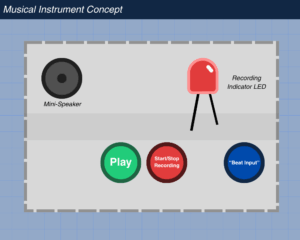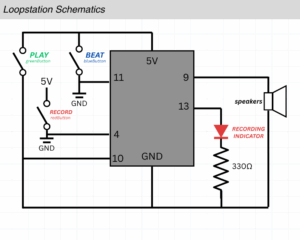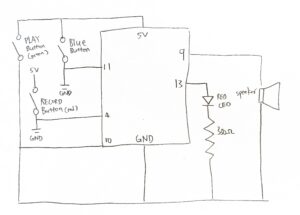This week Yongje and myself paired up to make our very own musical instrument.
I thought about the capabilities of the arduino speaker and was unimpressed with the sound “texture” of it, so we discussed what we could do with a rather limited range of sounds we could generate. I’m not much of a musician so I suggested what if we made a simple beat recorder, kinda like a metronome of sorts? Yongje informed me that what I was describing is called a “loopstation” and we got to designing.
Concept (With Visuals) – Hubert
After we planned what we wanted to do, I decided to visualize the user interaction side of the project first before designing the schematics and technical side.
The red button would be to start/stop the recording process. A red LED would indicate whether it was currently recording.
The blue button would be there for the user to tap in their beat.
When you are done with your beat, you can save it by clicking the red button once again. You can see whether it was properly stopped by the indicator turning off. Then you can press the green button to play your recorded beat.
Schematics & Planning – Hubert
Before we started connecting metal to metal, I made a schematic to quickly map out everything we needed to connect.
Code & Difficulties Encountered – Yongje
There are 3 main parts to the code.
The first is figuring out debouncing logic, which is used to remove the state when the system is bouncing between true and false when the switch is pressed. The second part is playback, actually playing back the recorded soundLastly, the third which is the hardest part: finding how to store the beat recording.
I’ll start by explaining the hardest part first, which is storing the beat recording.
The beat recording logic works by tracking the time of each button press and release while the device is in recording mode. Every time the beat button is pressed, the program calculates the gap since the previous press (gap = now – tRef) to capture the spacing between beats. When the button is released, it measures the duration the button was held (dur = now – lastPressTime) to record how long that beat lasted. Both values are stored in arrays (gaps[] and durs[]), building a timeline of when each beat starts and how long it plays. Figuring out this logic was the most difficult part.
Now onto explaining the playback logic. The playback logic is responsible for reproducing the rhythm that was recorded. It does this by reading through the stored arrays of gaps and durations in order. For each beat, the program first waits for the gap time, which is the delay before the next beat begins and then plays a tone on the speaker for the duration that was originally recorded. Because each recorded gap includes the previous beat’s duration, the playback code subtracts the previous duration from the current gap to get the true silent time between beats. This ensures that the playback matches the timing and spacing of the user’s original input, accurately reproducing both the rhythm and the length of each beat. I had to create a logic to turn negative silence time to positive because sometimes it gave errors when the inputs and the durations of beats were too short. This is explained in depth in the comment section of the code.
Finally, the debounce logic ensures that each button press or release is detected only once, even though mechanical switches naturally produce rapid, noisy fluctuations when pressed. When a button’s state changes, the program records the current time and waits a short period to confirm that the signal has stabilized. Only if the input remains steady for longer than this debounce delay does the program treat it as a valid press or release event. This filtering prevents false triggers caused by electrical noise or contact bounce, giving the system clean, reliable button inputs for recording and playback control. At first, I didn’t have this debounce logic implemented and had a hard time figuring out why the system sometimes failed to recognize button presses or seemed to trigger multiple times for a single press. Once the debounce logic was added, the button responses became stable and consistent.
Reflection
I believe this project turned out really well, and it was very interesting to work on our first group project of the semester.



